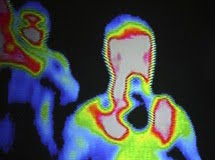“Up until now,
there have been no full-featured thermal network cameras available on the
market, and analogue thermal cameras have proven a challenge to integrate with
modern video surveillance systems”
THERMAL imaging
cameras give security managers on large sites with onsite response an
additional and affordable layer of monitoring that’s far less dependent on
expensive lighting solutions than ordinary CCTV cameras.
The heart of any
modern thermal imaging camera is the un-cooled microbolometer – essentially
that’s a bolometer fitted as an image sensor. This sensor is responsive to IRE
in the 8-13um range and when IRE reaches the microbolometer, it generates a
cascade of electrical signals based on resistance which can be analysed to
construct an image based on heat signals.
The thing is that
building a microbolometer is a fiddly and expensive business with some or all
of the fabrication process undertaken with the sensor encapsulated under a
vacuum. Also pushing up pricing is use of germanium in the lenses of thermal
cameras. This means even the most affordable thermal imaging cameras aren’t
cheap – up until this release from Axis you were talking up toward $5000 for
the more affordable units.
When you’re
selecting a thermal camera you want coverage of that long 8um to 13um spectral
band – that’s the spot you’ll get best penetration of smoke, fog, rain – and
darkness. And this is where the thermal camera really shines, as Axis clearly
understands.
“We see a great
demand from customers in high-end professional applications to enhance their IP
surveillance systems with thermal cameras,”says Johan Paulsson, chief
technology officer at Axis Communications.
“Up until now,
there have been no full-featured thermal network cameras available on the
market, and analogue thermal cameras have proven a challenge to integrate with
modern video surveillance systems. AXIS Q1910 and Q1910-E change this by being
the industry’s first thermal cameras that mesh perfectly with any network video
system, delivering all the benefits that customers have learned to expect from
network cameras.”
Axis has got both
indoor and outdoor applications covered. The AXIS Q1910 is designed for indoor
surveillance, while AXIS Q1910-E is an IP66-rated, outdoor-ready camera.
“AXIS Q1910/-E
Thermal Network Cameras are an excellent complement to conventional cameras
within area protection, perimeter monitoring and building security. Another
typical scenario is monitoring of freeways and railways – including platforms,
bridges and tunnels,” says Johan Paulsson.
Both cameras
offer competitive thermal imaging capabilities such as 160 x 128 resolution,
8.33 fps and 17-degree angle of view. In addition, they are unique on the
market in supporting key IP surveillance features such as H.264 and Motion
JPEG, audio, local storage and Power over Ethernet. Intelligent video is a key
component of any thermal camera, and AXIS Q1910/-E provide tampering alarm,
motion detection, and support for AXIS Camera Application Platform.
AXIS Q1910/-E
Thermal Network Cameras are supported by the industry’s largest base of video
management software through the Axis Application Development Partner program as
well as AXIS Camera Station. They also support the ONVIF specification for
interoperability of network video products. The cameras will be available in
January 2010 through Axis’ distribution channels.
The thermal
network cameras create images based on the heat that always radiates from any
object, vehicle or person. This gives thermal cameras the power to see through
complete darkness and deliver images that allow operators to detect and act on
suspicious activity. Thermal cameras can also handle many difficult weather
conditions better than conventional cameras, e.g. allowing operators to see
through haze, dust, and smoke.
Axis plans to
introduce new thermal cameras and may release 1 to 3 lens options in 2010. The
cameras are both PoE for ease of installation and they can detect intruders at
up to 220m and vehicles at up to 600m.
From an
application point of view, the strength of thermal cameras is intrusion
detection at night in high security applications where an onsite response team
is available. The images from thermal cameras are a bit like out-takes from
Predator. You will know there’s an intruder out there but there will be no
facial recognition and no ability to pick up distinguishing elements of
clothing style or colour.
In short, thermal
is a singular application for proactive security response with the use of
expensive and radiance polluting lighting systems.








